Advanced Financial Accounting 1: IFRS, CSR, and Intangible Assets
VerifiedAdded on 2020/10/22
|11
|2640
|134
Report
AI Summary
This report delves into key aspects of advanced financial accounting, beginning with an introduction to the role of finance in organizational sustainability and the significance of International Financial Reporting Standards (IFRS). It then analyzes the IFRS framework, outlining its objectives and qualitative characteristics of useful financial information. The report explores Corporate Social Responsibility (CSR) theories, including public interest, capture, and economic interest theories, and their impact on financial reporting. It examines intangible assets, asset impairment, and the challenges of fair value accounting, referencing the Enron case. Finally, it addresses the motivations of directors regarding property, plant, and equipment (PP&E) revaluation, the effects on financial statements, and the impact on shareholder wealth.
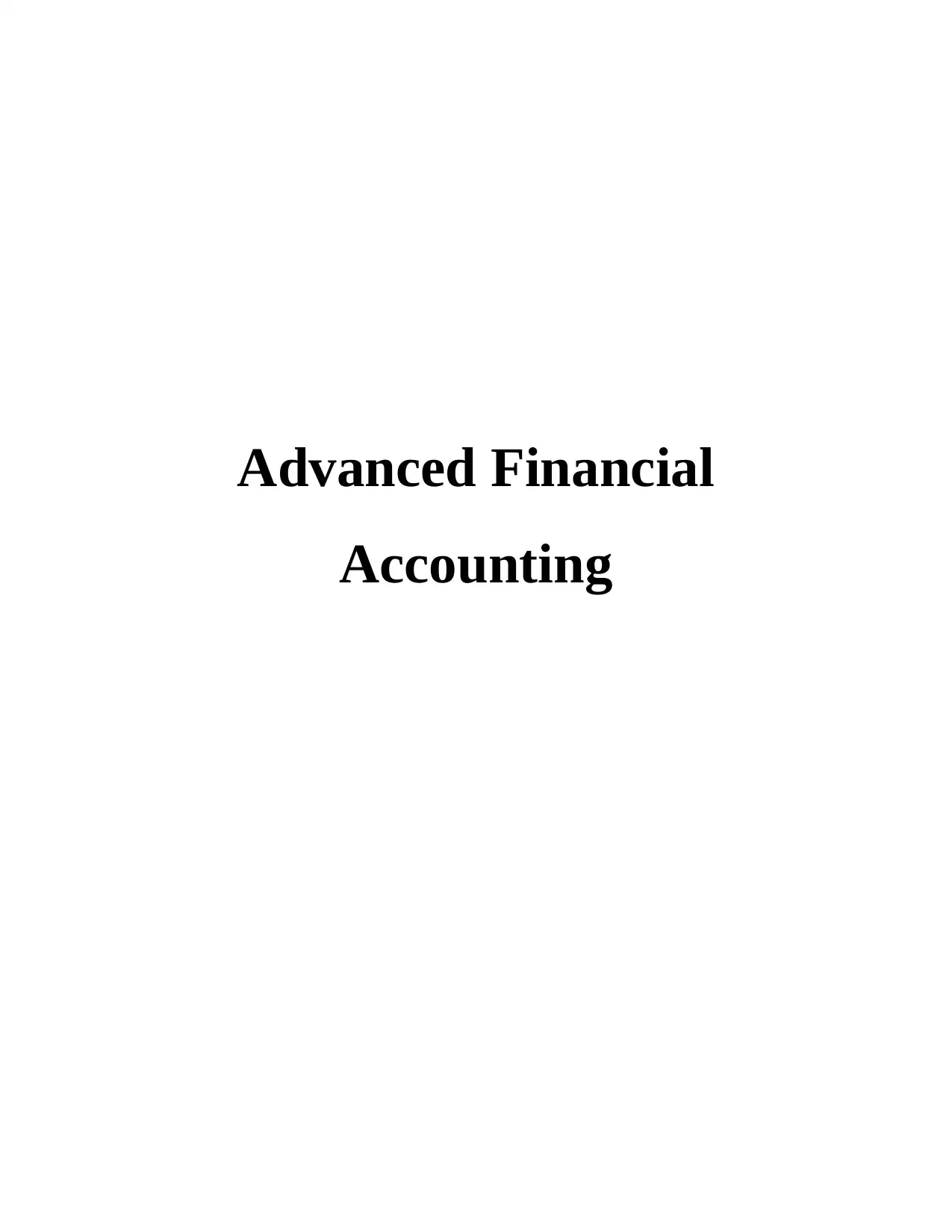
Advanced Financial
Accounting
Accounting
Paraphrase This Document
Need a fresh take? Get an instant paraphrase of this document with our AI Paraphraser

Contents
INTRODUCTION...........................................................................................................................1
TASK...............................................................................................................................................1
Assessment Task Part A..............................................................................................................1
Assessment Task Part B..............................................................................................................2
Assessment Task Part C..............................................................................................................4
Assessment Task Part D..............................................................................................................6
CONCLUSION................................................................................................................................7
REFERENCES................................................................................................................................8
INTRODUCTION...........................................................................................................................1
TASK...............................................................................................................................................1
Assessment Task Part A..............................................................................................................1
Assessment Task Part B..............................................................................................................2
Assessment Task Part C..............................................................................................................4
Assessment Task Part D..............................................................................................................6
CONCLUSION................................................................................................................................7
REFERENCES................................................................................................................................8

⊘ This is a preview!⊘
Do you want full access?
Subscribe today to unlock all pages.

Trusted by 1+ million students worldwide
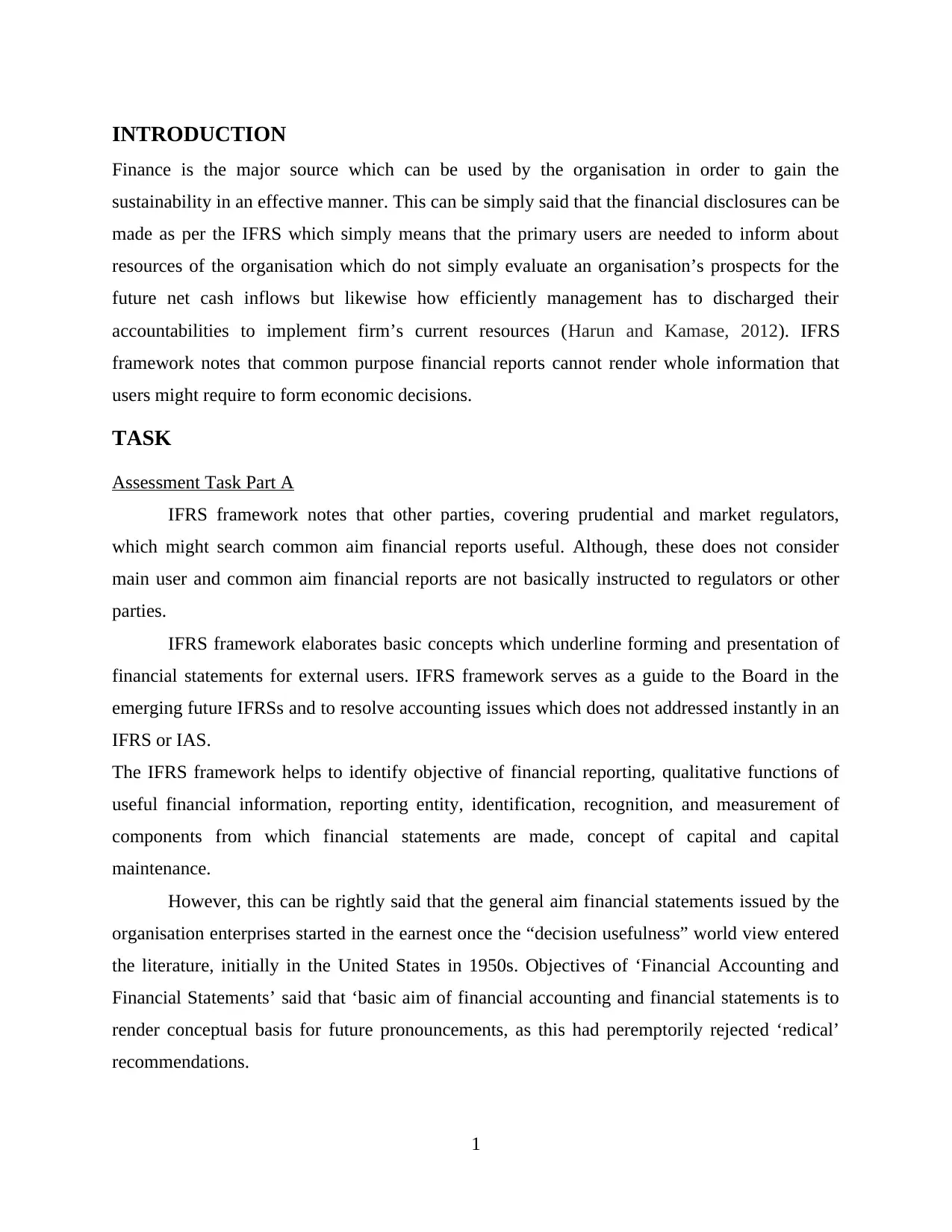
INTRODUCTION
Finance is the major source which can be used by the organisation in order to gain the
sustainability in an effective manner. This can be simply said that the financial disclosures can be
made as per the IFRS which simply means that the primary users are needed to inform about
resources of the organisation which do not simply evaluate an organisation’s prospects for the
future net cash inflows but likewise how efficiently management has to discharged their
accountabilities to implement firm’s current resources (Harun and Kamase, 2012). IFRS
framework notes that common purpose financial reports cannot render whole information that
users might require to form economic decisions.
TASK
Assessment Task Part A
IFRS framework notes that other parties, covering prudential and market regulators,
which might search common aim financial reports useful. Although, these does not consider
main user and common aim financial reports are not basically instructed to regulators or other
parties.
IFRS framework elaborates basic concepts which underline forming and presentation of
financial statements for external users. IFRS framework serves as a guide to the Board in the
emerging future IFRSs and to resolve accounting issues which does not addressed instantly in an
IFRS or IAS.
The IFRS framework helps to identify objective of financial reporting, qualitative functions of
useful financial information, reporting entity, identification, recognition, and measurement of
components from which financial statements are made, concept of capital and capital
maintenance.
However, this can be rightly said that the general aim financial statements issued by the
organisation enterprises started in the earnest once the “decision usefulness” world view entered
the literature, initially in the United States in 1950s. Objectives of ‘Financial Accounting and
Financial Statements’ said that ‘basic aim of financial accounting and financial statements is to
render conceptual basis for future pronouncements, as this had peremptorily rejected ‘redical’
recommendations.
1
Finance is the major source which can be used by the organisation in order to gain the
sustainability in an effective manner. This can be simply said that the financial disclosures can be
made as per the IFRS which simply means that the primary users are needed to inform about
resources of the organisation which do not simply evaluate an organisation’s prospects for the
future net cash inflows but likewise how efficiently management has to discharged their
accountabilities to implement firm’s current resources (Harun and Kamase, 2012). IFRS
framework notes that common purpose financial reports cannot render whole information that
users might require to form economic decisions.
TASK
Assessment Task Part A
IFRS framework notes that other parties, covering prudential and market regulators,
which might search common aim financial reports useful. Although, these does not consider
main user and common aim financial reports are not basically instructed to regulators or other
parties.
IFRS framework elaborates basic concepts which underline forming and presentation of
financial statements for external users. IFRS framework serves as a guide to the Board in the
emerging future IFRSs and to resolve accounting issues which does not addressed instantly in an
IFRS or IAS.
The IFRS framework helps to identify objective of financial reporting, qualitative functions of
useful financial information, reporting entity, identification, recognition, and measurement of
components from which financial statements are made, concept of capital and capital
maintenance.
However, this can be rightly said that the general aim financial statements issued by the
organisation enterprises started in the earnest once the “decision usefulness” world view entered
the literature, initially in the United States in 1950s. Objectives of ‘Financial Accounting and
Financial Statements’ said that ‘basic aim of financial accounting and financial statements is to
render conceptual basis for future pronouncements, as this had peremptorily rejected ‘redical’
recommendations.
1
Paraphrase This Document
Need a fresh take? Get an instant paraphrase of this document with our AI Paraphraser

‘Objectives of Financial Accounting and Financial Statements’ stated that “basic aim of
financial accounting and financial statements is to render quantitative financial information about
firm which is helpful to statement users, specifically owners and creditors, in forming economic
decisions. Statement rightly stated that the shareholders and actual creditors, not prospective
creditors. This is proceeded to enumerate and elaborates five “general objectives” about what
kinds of financial information organisation must render (Jarolim, and Öppinger, 2012).
The main aim of the International Financial Reporting Standard is to provide appropriate
information to the investors for making comparisons between organisations in international
capital markets. Which is the best tool to let the them know about the firmness of the
organisation. There are so many tools that can be used by the organisation for making business
objectives sustainable and reliable by using IFRS. As this helps out to satisfy the financial
reports in order to satisfy central objectives of financial reporting as determined in the
Conceptual Framework.
Assessment Task Part B
Corporate Social Responsibilities reflects not only a landscape of theories but likewise a
proliferation of approaches that are complicated. In practical manner, CSR theory reflects four
dimensions which are connected to earning, political performance, social demands and ethical
values.
Public Interest Theory: This theory regulates in order to protect and benefits at large. This
simply means that an economic concept which are strongly connected to welfare economics
which renders theoretical justifications for regulation. This theory notes that markets functions
by specific features such as imperfect contenders, asymmetric information, externalities, etc
which are not capable and experience market failure, that could be corrected along with use of
regulation. Theory is totally relied upon the main assumptions about nature of regulators: have
whole information, could guarantee perfect enforcement, and are benevolent (Rich, Jones,
Mowen and Hansen, 2012). Regulators are motivated by societal interests and join in the market
for improving social outcomes. As per this theory, the regulatory bodies contribute for the
promotion of the public interest. Public interest could further be elaborated as the best possible
allocation of scarce resources for individual and group products and services in the surrounding
areas in the society.
2
financial accounting and financial statements is to render quantitative financial information about
firm which is helpful to statement users, specifically owners and creditors, in forming economic
decisions. Statement rightly stated that the shareholders and actual creditors, not prospective
creditors. This is proceeded to enumerate and elaborates five “general objectives” about what
kinds of financial information organisation must render (Jarolim, and Öppinger, 2012).
The main aim of the International Financial Reporting Standard is to provide appropriate
information to the investors for making comparisons between organisations in international
capital markets. Which is the best tool to let the them know about the firmness of the
organisation. There are so many tools that can be used by the organisation for making business
objectives sustainable and reliable by using IFRS. As this helps out to satisfy the financial
reports in order to satisfy central objectives of financial reporting as determined in the
Conceptual Framework.
Assessment Task Part B
Corporate Social Responsibilities reflects not only a landscape of theories but likewise a
proliferation of approaches that are complicated. In practical manner, CSR theory reflects four
dimensions which are connected to earning, political performance, social demands and ethical
values.
Public Interest Theory: This theory regulates in order to protect and benefits at large. This
simply means that an economic concept which are strongly connected to welfare economics
which renders theoretical justifications for regulation. This theory notes that markets functions
by specific features such as imperfect contenders, asymmetric information, externalities, etc
which are not capable and experience market failure, that could be corrected along with use of
regulation. Theory is totally relied upon the main assumptions about nature of regulators: have
whole information, could guarantee perfect enforcement, and are benevolent (Rich, Jones,
Mowen and Hansen, 2012). Regulators are motivated by societal interests and join in the market
for improving social outcomes. As per this theory, the regulatory bodies contribute for the
promotion of the public interest. Public interest could further be elaborated as the best possible
allocation of scarce resources for individual and group products and services in the surrounding
areas in the society.
2
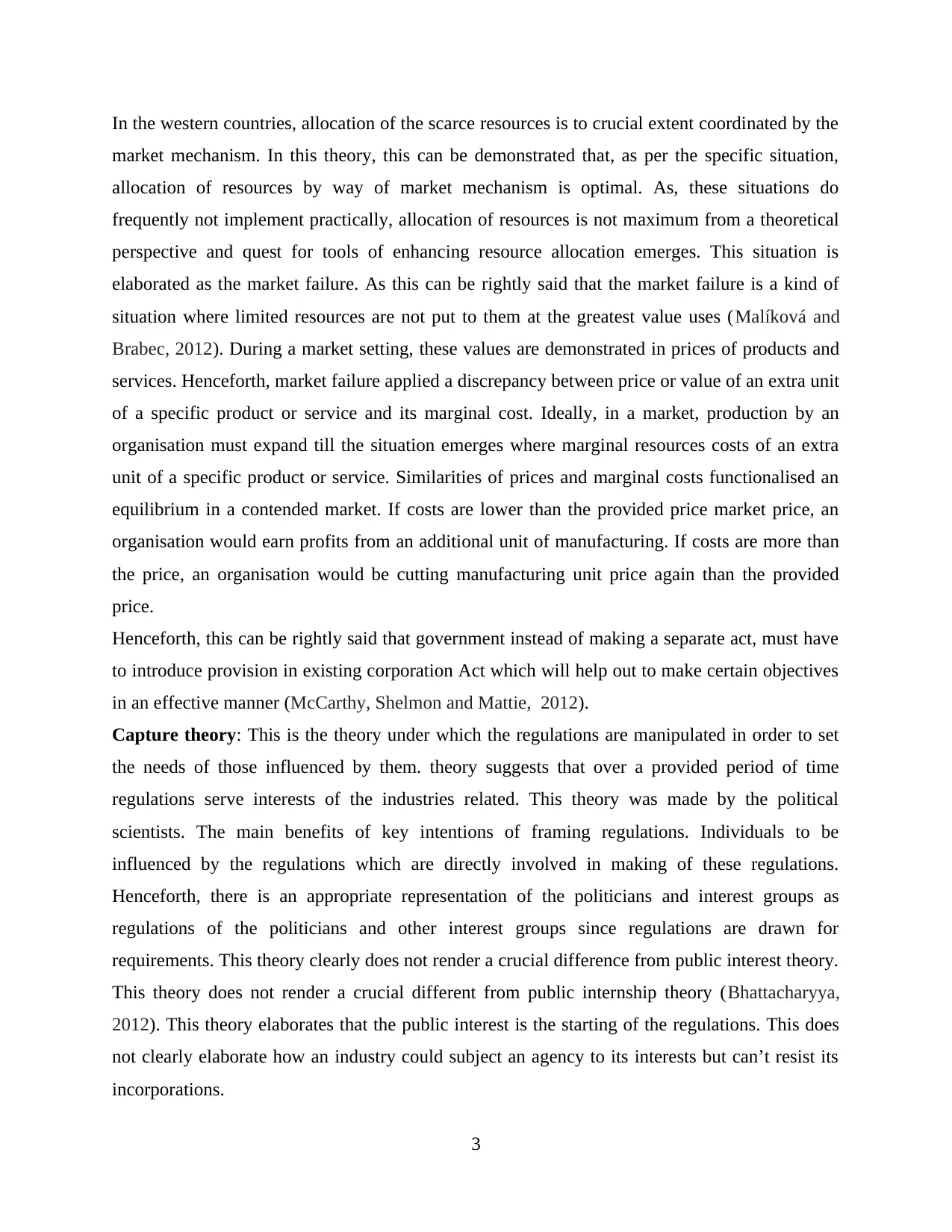
In the western countries, allocation of the scarce resources is to crucial extent coordinated by the
market mechanism. In this theory, this can be demonstrated that, as per the specific situation,
allocation of resources by way of market mechanism is optimal. As, these situations do
frequently not implement practically, allocation of resources is not maximum from a theoretical
perspective and quest for tools of enhancing resource allocation emerges. This situation is
elaborated as the market failure. As this can be rightly said that the market failure is a kind of
situation where limited resources are not put to them at the greatest value uses (Malíková and
Brabec, 2012). During a market setting, these values are demonstrated in prices of products and
services. Henceforth, market failure applied a discrepancy between price or value of an extra unit
of a specific product or service and its marginal cost. Ideally, in a market, production by an
organisation must expand till the situation emerges where marginal resources costs of an extra
unit of a specific product or service. Similarities of prices and marginal costs functionalised an
equilibrium in a contended market. If costs are lower than the provided price market price, an
organisation would earn profits from an additional unit of manufacturing. If costs are more than
the price, an organisation would be cutting manufacturing unit price again than the provided
price.
Henceforth, this can be rightly said that government instead of making a separate act, must have
to introduce provision in existing corporation Act which will help out to make certain objectives
in an effective manner (McCarthy, Shelmon and Mattie, 2012).
Capture theory: This is the theory under which the regulations are manipulated in order to set
the needs of those influenced by them. theory suggests that over a provided period of time
regulations serve interests of the industries related. This theory was made by the political
scientists. The main benefits of key intentions of framing regulations. Individuals to be
influenced by the regulations which are directly involved in making of these regulations.
Henceforth, there is an appropriate representation of the politicians and interest groups as
regulations of the politicians and other interest groups since regulations are drawn for
requirements. This theory clearly does not render a crucial difference from public interest theory.
This theory does not render a crucial different from public internship theory (Bhattacharyya,
2012). This theory elaborates that the public interest is the starting of the regulations. This does
not clearly elaborate how an industry could subject an agency to its interests but can’t resist its
incorporations.
3
market mechanism. In this theory, this can be demonstrated that, as per the specific situation,
allocation of resources by way of market mechanism is optimal. As, these situations do
frequently not implement practically, allocation of resources is not maximum from a theoretical
perspective and quest for tools of enhancing resource allocation emerges. This situation is
elaborated as the market failure. As this can be rightly said that the market failure is a kind of
situation where limited resources are not put to them at the greatest value uses (Malíková and
Brabec, 2012). During a market setting, these values are demonstrated in prices of products and
services. Henceforth, market failure applied a discrepancy between price or value of an extra unit
of a specific product or service and its marginal cost. Ideally, in a market, production by an
organisation must expand till the situation emerges where marginal resources costs of an extra
unit of a specific product or service. Similarities of prices and marginal costs functionalised an
equilibrium in a contended market. If costs are lower than the provided price market price, an
organisation would earn profits from an additional unit of manufacturing. If costs are more than
the price, an organisation would be cutting manufacturing unit price again than the provided
price.
Henceforth, this can be rightly said that government instead of making a separate act, must have
to introduce provision in existing corporation Act which will help out to make certain objectives
in an effective manner (McCarthy, Shelmon and Mattie, 2012).
Capture theory: This is the theory under which the regulations are manipulated in order to set
the needs of those influenced by them. theory suggests that over a provided period of time
regulations serve interests of the industries related. This theory was made by the political
scientists. The main benefits of key intentions of framing regulations. Individuals to be
influenced by the regulations which are directly involved in making of these regulations.
Henceforth, there is an appropriate representation of the politicians and interest groups as
regulations of the politicians and other interest groups since regulations are drawn for
requirements. This theory clearly does not render a crucial difference from public interest theory.
This theory does not render a crucial different from public internship theory (Bhattacharyya,
2012). This theory elaborates that the public interest is the starting of the regulations. This does
not clearly elaborate how an industry could subject an agency to its interests but can’t resist its
incorporations.
3
⊘ This is a preview!⊘
Do you want full access?
Subscribe today to unlock all pages.

Trusted by 1+ million students worldwide
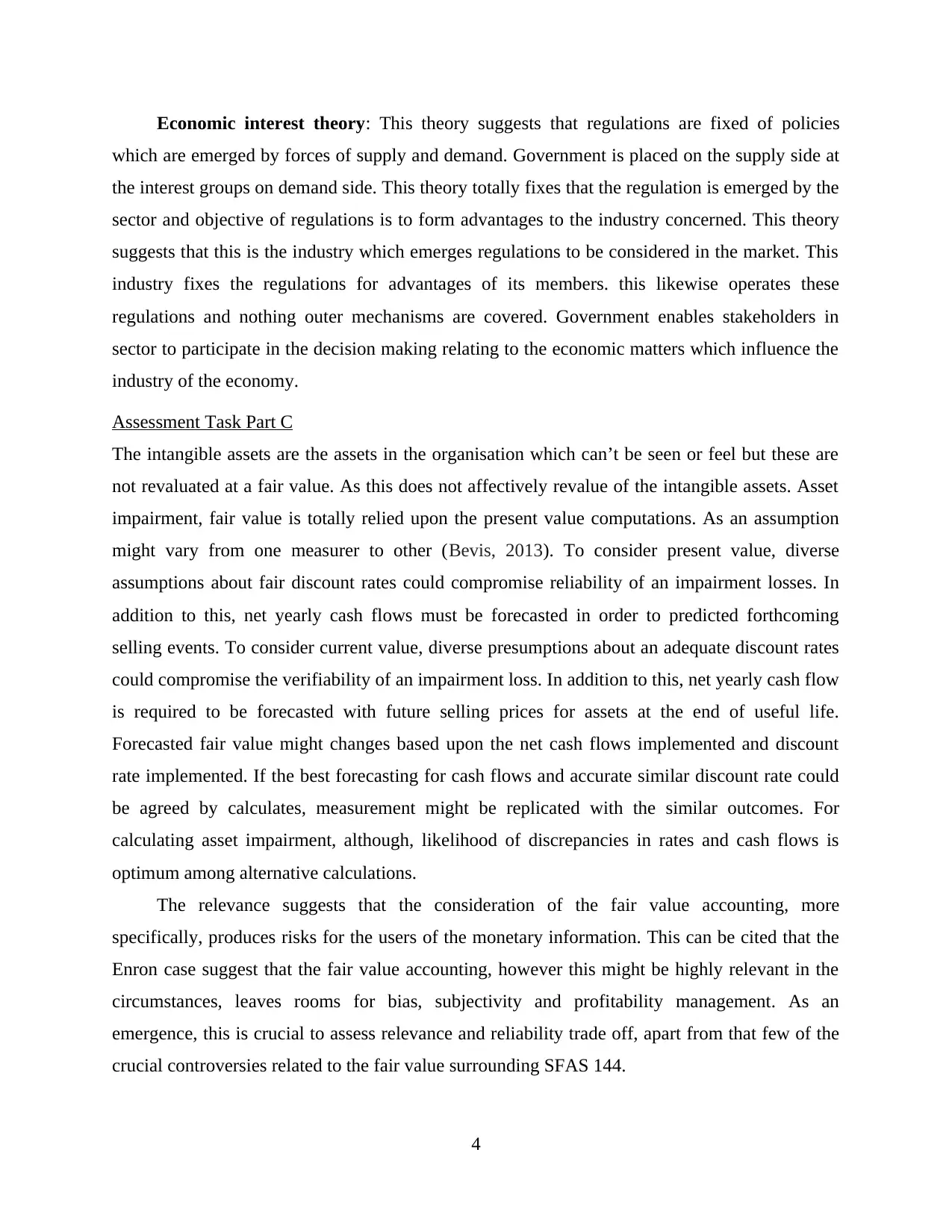
Economic interest theory: This theory suggests that regulations are fixed of policies
which are emerged by forces of supply and demand. Government is placed on the supply side at
the interest groups on demand side. This theory totally fixes that the regulation is emerged by the
sector and objective of regulations is to form advantages to the industry concerned. This theory
suggests that this is the industry which emerges regulations to be considered in the market. This
industry fixes the regulations for advantages of its members. this likewise operates these
regulations and nothing outer mechanisms are covered. Government enables stakeholders in
sector to participate in the decision making relating to the economic matters which influence the
industry of the economy.
Assessment Task Part C
The intangible assets are the assets in the organisation which can’t be seen or feel but these are
not revaluated at a fair value. As this does not affectively revalue of the intangible assets. Asset
impairment, fair value is totally relied upon the present value computations. As an assumption
might vary from one measurer to other (Bevis, 2013). To consider present value, diverse
assumptions about fair discount rates could compromise reliability of an impairment losses. In
addition to this, net yearly cash flows must be forecasted in order to predicted forthcoming
selling events. To consider current value, diverse presumptions about an adequate discount rates
could compromise the verifiability of an impairment loss. In addition to this, net yearly cash flow
is required to be forecasted with future selling prices for assets at the end of useful life.
Forecasted fair value might changes based upon the net cash flows implemented and discount
rate implemented. If the best forecasting for cash flows and accurate similar discount rate could
be agreed by calculates, measurement might be replicated with the similar outcomes. For
calculating asset impairment, although, likelihood of discrepancies in rates and cash flows is
optimum among alternative calculations.
The relevance suggests that the consideration of the fair value accounting, more
specifically, produces risks for the users of the monetary information. This can be cited that the
Enron case suggest that the fair value accounting, however this might be highly relevant in the
circumstances, leaves rooms for bias, subjectivity and profitability management. As an
emergence, this is crucial to assess relevance and reliability trade off, apart from that few of the
crucial controversies related to the fair value surrounding SFAS 144.
4
which are emerged by forces of supply and demand. Government is placed on the supply side at
the interest groups on demand side. This theory totally fixes that the regulation is emerged by the
sector and objective of regulations is to form advantages to the industry concerned. This theory
suggests that this is the industry which emerges regulations to be considered in the market. This
industry fixes the regulations for advantages of its members. this likewise operates these
regulations and nothing outer mechanisms are covered. Government enables stakeholders in
sector to participate in the decision making relating to the economic matters which influence the
industry of the economy.
Assessment Task Part C
The intangible assets are the assets in the organisation which can’t be seen or feel but these are
not revaluated at a fair value. As this does not affectively revalue of the intangible assets. Asset
impairment, fair value is totally relied upon the present value computations. As an assumption
might vary from one measurer to other (Bevis, 2013). To consider present value, diverse
assumptions about fair discount rates could compromise reliability of an impairment losses. In
addition to this, net yearly cash flows must be forecasted in order to predicted forthcoming
selling events. To consider current value, diverse presumptions about an adequate discount rates
could compromise the verifiability of an impairment loss. In addition to this, net yearly cash flow
is required to be forecasted with future selling prices for assets at the end of useful life.
Forecasted fair value might changes based upon the net cash flows implemented and discount
rate implemented. If the best forecasting for cash flows and accurate similar discount rate could
be agreed by calculates, measurement might be replicated with the similar outcomes. For
calculating asset impairment, although, likelihood of discrepancies in rates and cash flows is
optimum among alternative calculations.
The relevance suggests that the consideration of the fair value accounting, more
specifically, produces risks for the users of the monetary information. This can be cited that the
Enron case suggest that the fair value accounting, however this might be highly relevant in the
circumstances, leaves rooms for bias, subjectivity and profitability management. As an
emergence, this is crucial to assess relevance and reliability trade off, apart from that few of the
crucial controversies related to the fair value surrounding SFAS 144.
4
Paraphrase This Document
Need a fresh take? Get an instant paraphrase of this document with our AI Paraphraser
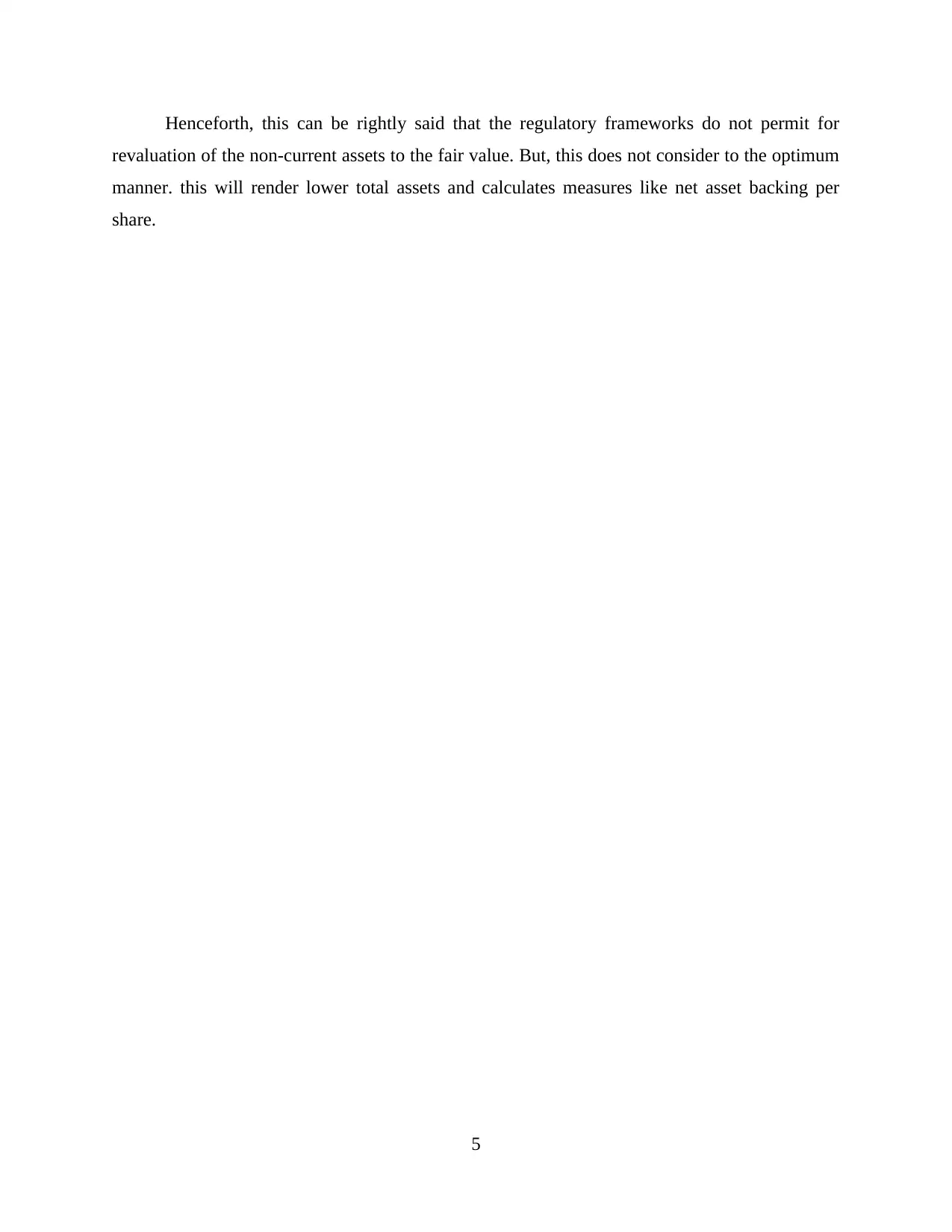
Henceforth, this can be rightly said that the regulatory frameworks do not permit for
revaluation of the non-current assets to the fair value. But, this does not consider to the optimum
manner. this will render lower total assets and calculates measures like net asset backing per
share.
5
revaluation of the non-current assets to the fair value. But, this does not consider to the optimum
manner. this will render lower total assets and calculates measures like net asset backing per
share.
5

Assessment Task Part D
a. What motivates director to not to revalue the property, plant and equipment
Property, Plant and Equipment are the most essential asset to a company and also for the
operation of business. It is not easy to liquidate these assets (Beatty and Liao, 2014). These
assets are palpable and are of utmost importance to generate economic profits for a company for
a year or more than that.
Measuring PP&E at fair value will increase the amount of yearly based assets and that
would lead in paying of more taxes whereas when it is done according to the cost model, results
are just opposite. The properties purchased for a long time ago, the current fair value of the
products are outdated as compared to current carrying amount. If the revaluation is done on the
basis of fair value model that will increase the depreciation value of the asset, which would end
up in low cost value of the PP&E in the current scenario. The directors use the cost model to get
a less depreciable value of the assets so that the actual cost of the PP&E does not get affected
and company would not face any losses due to such depreciation.
b. Effect on firm's financial statements
When the revaluation is done according to the fair value then the cost of assets shown in
the financial statement will leads to the payment of more taxes and less profit. Revaluation of the
asset according to the current values of asset provide the companies the actual value of PP&E on
the financial statements (Weil, Schipper and Francis, 2013). The main purpose of revaluation is
to provide the balance sheet with present or current values, increase in value are not considered
as the part of income but are added in equity and no profit and loss are regarded in this income.
The lower the amount in the financial statement the less company will be entitled for loan for
their business.
c. Effect on the wealth of shareholders
If the valuation is done according to the fair value, then the amount of loss will be
incurred from the capital invested by the shareholders (Scott, 2015). If the amount of asset is
decreased due to revaluation, then such decrease is included in profit or loss to the company.
Similarly, if there is an increase then it shall be considered in profit or loss in order to reverse the
decreased revaluation which was done before of the same asset. It is about balancing the debt of
the company has incurred due to the depreciation. The shareholder’s equity tends to grow more if
assets value of the organisation is less than their dividend is lowering down form their earnings.
6
a. What motivates director to not to revalue the property, plant and equipment
Property, Plant and Equipment are the most essential asset to a company and also for the
operation of business. It is not easy to liquidate these assets (Beatty and Liao, 2014). These
assets are palpable and are of utmost importance to generate economic profits for a company for
a year or more than that.
Measuring PP&E at fair value will increase the amount of yearly based assets and that
would lead in paying of more taxes whereas when it is done according to the cost model, results
are just opposite. The properties purchased for a long time ago, the current fair value of the
products are outdated as compared to current carrying amount. If the revaluation is done on the
basis of fair value model that will increase the depreciation value of the asset, which would end
up in low cost value of the PP&E in the current scenario. The directors use the cost model to get
a less depreciable value of the assets so that the actual cost of the PP&E does not get affected
and company would not face any losses due to such depreciation.
b. Effect on firm's financial statements
When the revaluation is done according to the fair value then the cost of assets shown in
the financial statement will leads to the payment of more taxes and less profit. Revaluation of the
asset according to the current values of asset provide the companies the actual value of PP&E on
the financial statements (Weil, Schipper and Francis, 2013). The main purpose of revaluation is
to provide the balance sheet with present or current values, increase in value are not considered
as the part of income but are added in equity and no profit and loss are regarded in this income.
The lower the amount in the financial statement the less company will be entitled for loan for
their business.
c. Effect on the wealth of shareholders
If the valuation is done according to the fair value, then the amount of loss will be
incurred from the capital invested by the shareholders (Scott, 2015). If the amount of asset is
decreased due to revaluation, then such decrease is included in profit or loss to the company.
Similarly, if there is an increase then it shall be considered in profit or loss in order to reverse the
decreased revaluation which was done before of the same asset. It is about balancing the debt of
the company has incurred due to the depreciation. The shareholder’s equity tends to grow more if
assets value of the organisation is less than their dividend is lowering down form their earnings.
6
⊘ This is a preview!⊘
Do you want full access?
Subscribe today to unlock all pages.

Trusted by 1+ million students worldwide

morethbookvaluevalue of total assets increases.
CONCLUSION
From the above mentioned report, this is simply said that organisation is required to
adopt financial reporting as per the reporting framework. In this report, various public interest
theory, capture theory, Economic interest group theory of regulations are considered. Regulatory
rules for impairment or disposal of long –lived assets are considered.
7
CONCLUSION
From the above mentioned report, this is simply said that organisation is required to
adopt financial reporting as per the reporting framework. In this report, various public interest
theory, capture theory, Economic interest group theory of regulations are considered. Regulatory
rules for impairment or disposal of long –lived assets are considered.
7
Paraphrase This Document
Need a fresh take? Get an instant paraphrase of this document with our AI Paraphraser
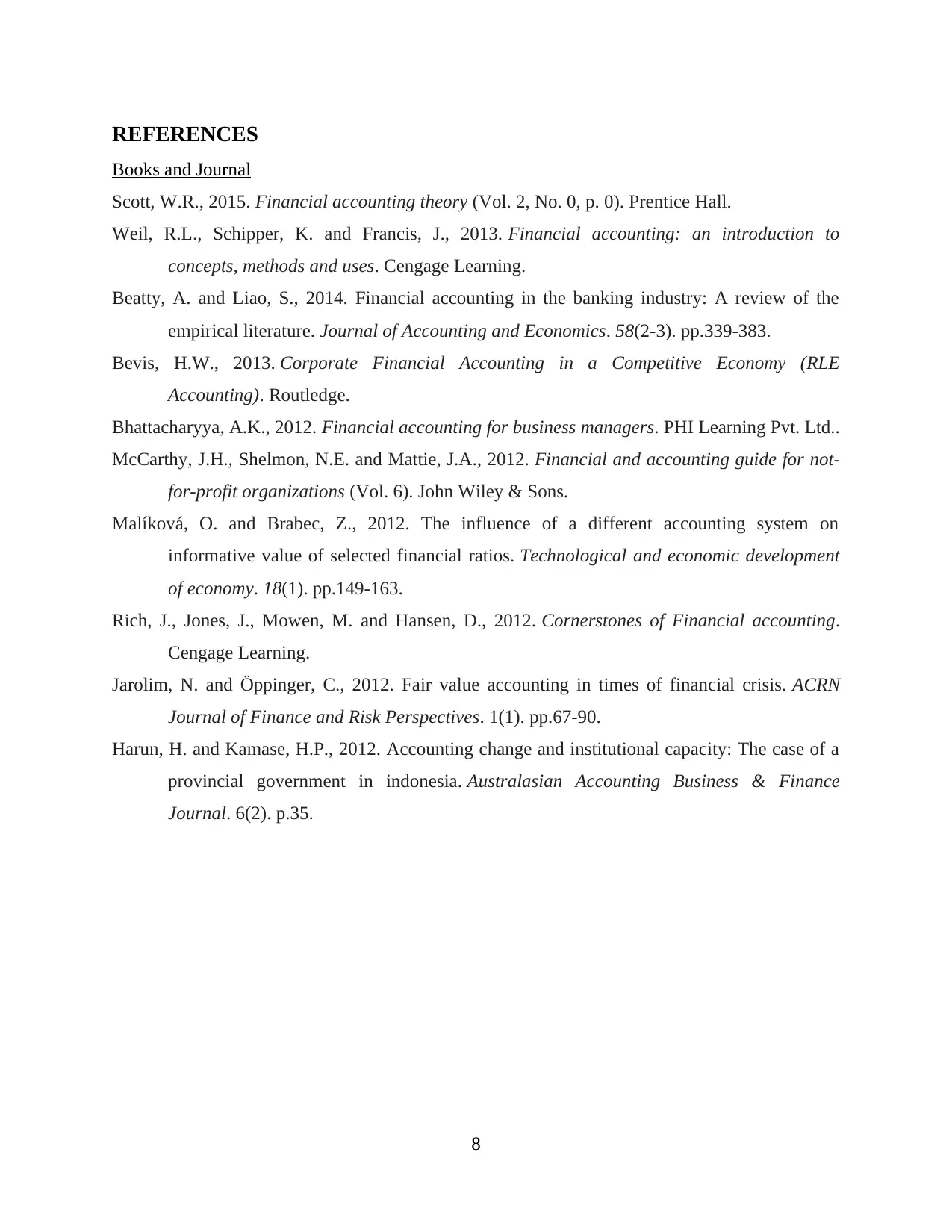
REFERENCES
Books and Journal
Scott, W.R., 2015. Financial accounting theory (Vol. 2, No. 0, p. 0). Prentice Hall.
Weil, R.L., Schipper, K. and Francis, J., 2013. Financial accounting: an introduction to
concepts, methods and uses. Cengage Learning.
Beatty, A. and Liao, S., 2014. Financial accounting in the banking industry: A review of the
empirical literature. Journal of Accounting and Economics. 58(2-3). pp.339-383.
Bevis, H.W., 2013. Corporate Financial Accounting in a Competitive Economy (RLE
Accounting). Routledge.
Bhattacharyya, A.K., 2012. Financial accounting for business managers. PHI Learning Pvt. Ltd..
McCarthy, J.H., Shelmon, N.E. and Mattie, J.A., 2012. Financial and accounting guide for not-
for-profit organizations (Vol. 6). John Wiley & Sons.
Malíková, O. and Brabec, Z., 2012. The influence of a different accounting system on
informative value of selected financial ratios. Technological and economic development
of economy. 18(1). pp.149-163.
Rich, J., Jones, J., Mowen, M. and Hansen, D., 2012. Cornerstones of Financial accounting.
Cengage Learning.
Jarolim, N. and Öppinger, C., 2012. Fair value accounting in times of financial crisis. ACRN
Journal of Finance and Risk Perspectives. 1(1). pp.67-90.
Harun, H. and Kamase, H.P., 2012. Accounting change and institutional capacity: The case of a
provincial government in indonesia. Australasian Accounting Business & Finance
Journal. 6(2). p.35.
8
Books and Journal
Scott, W.R., 2015. Financial accounting theory (Vol. 2, No. 0, p. 0). Prentice Hall.
Weil, R.L., Schipper, K. and Francis, J., 2013. Financial accounting: an introduction to
concepts, methods and uses. Cengage Learning.
Beatty, A. and Liao, S., 2014. Financial accounting in the banking industry: A review of the
empirical literature. Journal of Accounting and Economics. 58(2-3). pp.339-383.
Bevis, H.W., 2013. Corporate Financial Accounting in a Competitive Economy (RLE
Accounting). Routledge.
Bhattacharyya, A.K., 2012. Financial accounting for business managers. PHI Learning Pvt. Ltd..
McCarthy, J.H., Shelmon, N.E. and Mattie, J.A., 2012. Financial and accounting guide for not-
for-profit organizations (Vol. 6). John Wiley & Sons.
Malíková, O. and Brabec, Z., 2012. The influence of a different accounting system on
informative value of selected financial ratios. Technological and economic development
of economy. 18(1). pp.149-163.
Rich, J., Jones, J., Mowen, M. and Hansen, D., 2012. Cornerstones of Financial accounting.
Cengage Learning.
Jarolim, N. and Öppinger, C., 2012. Fair value accounting in times of financial crisis. ACRN
Journal of Finance and Risk Perspectives. 1(1). pp.67-90.
Harun, H. and Kamase, H.P., 2012. Accounting change and institutional capacity: The case of a
provincial government in indonesia. Australasian Accounting Business & Finance
Journal. 6(2). p.35.
8
1 out of 11
Related Documents
Your All-in-One AI-Powered Toolkit for Academic Success.
+13062052269
info@desklib.com
Available 24*7 on WhatsApp / Email
![[object Object]](/_next/static/media/star-bottom.7253800d.svg)
Unlock your academic potential
Copyright © 2020–2025 A2Z Services. All Rights Reserved. Developed and managed by ZUCOL.




